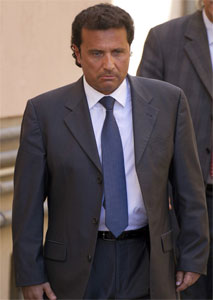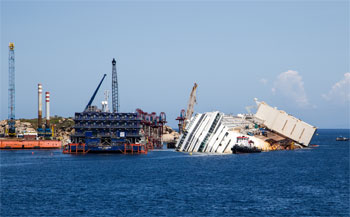A captain who took an unscheduled side trip using the wrong scale chart and sailing too fast, too close to a poorly lit coastline were among the causes of the Costa Concordia disaster, an Italian investigator report said.
The cruise ship struck rocks about a half-mile off Giglio Island and sank, which resulted in 32 deaths. At least 157 people were injured.
The failure of the bridge team to speak up to warn the captain of the looming danger to the ship was called “reprehensible,” according to an English translation of the casualty investigation issued in May by the Italian Ministry of Infrastructure and Transport.
The disaster was made much worse by mistakes made after the vessel struck rocks. Capt. Francesco Schettino, bridge officers and Costa Crociere SpA officials did not immediately tell proper authorities about the casualty and they played down its severity. Schettino waited nearly an hour to sound the general alarm, and he and the crew did not follow proper emergency and evacuation procedures, the report said.
 |
|
Associated Press/Andrew Medichini |
|
Capt. Francesco Schettino leaves an Italian court hearing in May. The former Costa Concordia captain is charged with manslaughter. |
The casualty is “a unique example for the lessons which may be learnt, despite the human tragedy and the master’s unconventional behavior, which represents the main cause of the shipwreck,” the investigators wrote.
Schettino’s trial on multiple counts of manslaughter, causing the casualty and abandoning the vessel was scheduled for July. Five other crew and company officials are facing trial.
The report raised concerns about the immediate failure of the emergency generator that led to a shipwide blackout. Another issue was the location of essential equipment in Costa Concordia, such as the diesel generators, propulsion motors and bilge pumps in five adjacent watertight compartments, which flooded within minutes of the grounding.
This casualty emphasizes the importance of cruise companies investing in safety, said Clark Dodge, a Hawaii-based passenger vessel safety consultant.
“All those millions of dollars spent making the cabin and amenities gorgeous — I have no problem with that,” Dodge said. “But make sure the support goes along with it, in terms of safety and equipment.”
Costa Concordia, carrying 3,206 passengers and 1,023 crew, left the port of Civitavecchia at 1918 on Jan. 13, headed for Savona. The original voyage plan was a standard route between Civitavecchia and Savona. Schettino verbally told the Civitavecchia harbor master that he was changing the ship’s route. Schettino then took the ship close to Giglio Island to perform a “salute.”
At 2145 local time, the 952-foot cruise ship struck Scole Rocks, about a half-mile off Giglio Island. The impact caused a 174-foot hull breach on the vessel’s port side.
Schettino did not tell search and rescue authorities about the incident right away. At 2207 the Italian coast guard unit at Civitavecchia contacted the ship. The captain reported a blackout and stated, “The situation is under control,” according to the report. At 2222 Schettino asked the Civitavecchia coast guard for the help of two tugs because of a breach in the hull, stating that there were no injuries.
But Schettino already knew that the situation was dire, investigators said. Within three minutes, the captain knew about the immediate flooding of watertight compartments (WTC). In 10 minutes, Schettino knew that WTCs 4, 5, 6, and 7 were flooded.
Numerous mistakes were made regarding the emergency and evacuation orders. Schettino did not announce a general emergency until 48 minutes after striking the rocks. An abandon-ship order, which was not heard or understood by many passengers, was given an hour and nine minutes after grounding. At 2255 the first lifeboats were lowered. At 2320 Schettino and all other officers, except for the second officer, abandoned the bridge. At this point, there were 300 passengers and crew still on board, and the ship was listing between 25° to 30°. Some passengers ended up jumping into the sea. By 2400 the list reached 40°. Schettino did not activate the muster list, and he abandoned ship while passengers and crew were still on board.
“There was chaos and confusion; lack of communication” during the evacuation, the authors of the casualty report wrote. “In other words, complete disorganization.”
Some of the errors included: The cruise director sent passengers away from muster stations, asking them to return to the lounges; most of the deck staff were disoriented and did not follow procedures, and some crew told passengers in the corridors to return to their cabins, saying that the crisis was only a blackout which would be resolved soon.
In addition, there were communication problems among crewmembers and between crewmembers and passengers that hampered emergency and evacuation procedures. There were 38 nationalities represented by the ship’s crew. Italian was the working language. The first engineer, a Bulgarian, said he did not fully understand orders given in Italian. The helmsman twice did not understand the captain’s orders given in English just before the grounding. The radio officer said that the boatswain, while lowering a lifeboat, gave orders in Italian and English to crewmembers from South America. Some U.S. passengers said many of the crew at muster stations did not speak English.
The report states these errors were because of the different backgrounds and training of the crew. “It appears, therefore, that the recruitment of crewmembers, carried out by external agencies worldwide, plays a fundamental role in the management of emergencies,” the report’s authors wrote. The report states that a more internationally shared language, instead of Italian, would have helped during the emergency phase.
Errors were made as Costa Concordia approached Giglio Island. A chart of at least 1/50.000 should have been used; instead a chart of 1/100.000 scale was used.
When Costa Concordia left Civitavecchia, officers on the bridge were the first officer, second officer, third officer, apprentice and helmsman, according to the report. The chief purser, hotel director and catering services manager were also on the bridge.
Schettino came on the bridge about 10 minutes before the casualty. Three minutes later the captain made a phone call.
When Schettino took command, Costa Concordia was at a heading of 290°. He ordered the helmsman to change course to 300°, to increase speed to 16 knots and pull “gently” to 310°. At 2140 Schettino ordered a course, in English, “325.” In confirming, the helmsman answered “315” and the first officer attempted to correct the helmsman, but stated “335.” The captain restated “325” which the helmsman repeated correctly. Two minutes later, the captain ordered “350” but the helmsman repeated “340.” The order is repeated and confirmed correctly.
The radius of the turn took Costa Concordia much closer to Giglio Island than the captain had planned. Schettino then switched to rudder angles for his orders. Mistakes made during this part of the trip were: Windows on the bridge were closed, preventing awareness of the sea crashing against nearby rocks; shifting from a perpendicular to a parallel course extremely close to the coast; the bridge team not paying attention to ship steering, checking the ship’s position and lookout; Schettino’s poor review of a hazardous navigation plan; using the wrong chart and failing to take into account the distance to the coast; and failing to rely on support of the bridge team. The first officer said that Schettino had difficulty reading the radar screen since he had the wrong glasses on.
The report criticizes the passive attitude of the bridge before the grounding. “Nobody seemed to have urged the master to accelerate the turn or to give warning on the looming danger,” the authors wrote.
The report raises concerns about the loss of emergency power in the vessel. The emergency generator ran for 41 seconds before shutting off. As a consequence, there was no power for the emergency bilge pumps. The rudder became completely blocked starboard and no longer handled.
The UPS batteries did kick in, powering internal communications and some emergency lighting. However, several passengers said their cabins were in total darkness and they had to use the light from their cellphones to find their life jackets.
Dodge said that there should be emergency lighting that runs off individual batteries. “Every space that has the possibility of a passenger in it should have a separate emergency light that is separate from the main bus,” he said.
Another concern was the concentration of vital equipment in the five watertight compartments that flooded (4, 5, 6, 7 and 8). WTC 4 contained the main thrust bearings and hydraulic units. WTC 5 contained the propulsion electric motors, fire and bilge pumps, propulsion and engine ventilation transformers and propulsion transformers. WTC 6 contained three main diesel generators, aft. WTC 7 contained three main diesel generators, forward. WTC 8 contained the ballast and bilge pumps. The report recommends, for newbuilds, double-skin protection for WTCs containing vital equipment for propulsion and electricity.
The report suggests that two items be discussed: locating essential systems in watertight compartments, not next to each other, and more detailed requirements for the distribution, along the length of the ship, of bilge pumps so that at least one bilge pump can drain huge quantities of water.
Dodge was disappointed that there was not more information about the engineering issues with the ship. “It pointed fingers at management and operations,” he said. “I thought to myself, from a chief engineer standpoint, maybe there should be a separate engineering report.”

